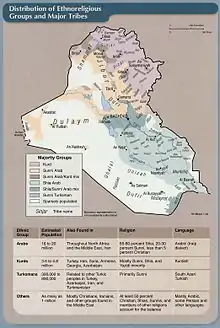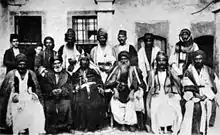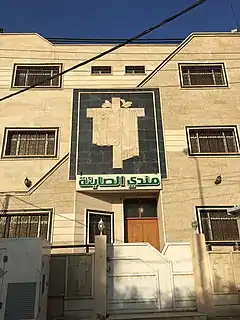Religion in Iraq
Religion in Iraq dates back to Ancient Mesopotamia, particularly Sumer, Akkad, Assyria and Babylonia between circa 3500 BC and 400 AD, after which they largely gave way to Syriac Christianity and later to Islam.[1][2]
A national census has not been held since 1987.[4] In the 2020s, the country is overwhelmingly Muslim, who are split into two distinct sects, Shia and Sunni. Approximately 95% to 98% of the population are Muslims, with Shia Muslims constituting a slight majority.[5][6]
The remainder follow Christianity, Yazidism, Mandaeism and Yarsanism.
History
The religious development of Mesopotamia and Mesopotamian culture in general, especially in the south, was not particularly influenced by the movements of the various peoples into and throughout the area. Rather, Mesopotamian religion was a consistent and coherent tradition which adapted to the internal needs of its adherents over millennia of development.[1]
There was increasing syncretism between the Sumerian and Akkadian cultures and deities, with the Akkadians typically preferring to worship fewer deities but elevating them to greater positions of power. Circa 2335 BC, Sargon of Akkad conquered all of Mesopotamia, uniting its inhabitants into the world's first empire and spreading its domination into ancient Iran, the Levant, Anatolia, Canaan and the Arabian Peninsula. The Akkadian Empire endured for two centuries before collapsing due to economic decline, internal strife and attacks from the north east by the Gutian people.
Modern era
The “Global Index of Religiosity and Atheism” listed Iraq as one of six countries as having the lowest rate of atheism in 2012. After six years, with religious figures coming to power, the situation changed fast as the tide of religiosity receded. According to Iraqi thinker Izzat Shahbandar, this came after ther ruling political class came to power, and their role in sectarianism and state corruption, and by regularly occupying television slots to spread their agendas. The increasing prevalence of atheism and agnosticism signals a tidal public opinion change.[7][8]
Islam
Iraq's Muslims follow two distinct traditions, Shia and Sunni Islam. According to the CIA World Factbook, Iraq is approximately 95% to 98% Muslim, with approximately 61-64% Shia Muslims and 29–34% Sunni Muslims.[5] According to a 2011 survey by Pew Research, 51% of the Muslims identify as Shia and 42% as Sunni.[6] Iraq is home to many religious sites important for both Shia and Sunni Muslims.

Baghdad was a hub of Islamic learning and scholarship for centuries and served as the capital of the Abassids. The city of Karbala has substantial prominence in Shia Islam as a result of the Battle of Karbala, which was fought on the site of the modern city on October 10, 680. Similarly, Najaf is renowned as the site of the tomb of Alī ibn Abī Tālib (also known as "Imām Alī"). The Shia consider him to be the righteous caliph and first imām. The city is now a great center of pilgrimage from throughout the Shia Islamic world even though his grave is debatable and it is estimated that only Mecca and Medina receive more Muslim pilgrims.
The city of Kufa was home to the famed Sunni scholar Abu Hanifah, whose school of thought is followed by a sizable number of Sunnis across the globe. Likewise, Samarra is home to the al-Askari Mosque, containing the mausoleums of the Ali al-Hadi and Hasan al-Askari, the tenth and eleventh Shia Imams, respectively, as well as the shrine of Muhammad al-Mahdi, known as the "Hidden Imam", who is the twelfth and final Imam of the Shia of the Ja'farī Madhhab. This has made it an important pilgrimage centre for Ja'farī Shia Muslims. In addition, some female relatives of the Islamic prophet Muhammad are buried in Samarra, making the city one of the most significant sites of worship for Shia and a venerated location for Sunnis.
Smaller sects of Islam exist in the country, such as the small Shia Shaykhist community concentrated in Basra and Karbala.
Arabs
Iraqi Arabs are a mix between Shia Muslims and Sunni Muslims. The Arab Sunni Muslims live mainly in the area of the so-called Sunni Triangle, but there are other communities in other parts of the country, whereas the Arab Shia Muslims live mainly in Southeast Iraq. The capital Baghdad is mixed of Arab Sunni Muslims and Arab Shia Muslims as well as other religions.
Kurds
Iraqi Kurds are 98% Sunni Muslims, with a Shia Feyli minority of 2%.[9] Most Kurds are located in the northern areas of the country. Most Iraqi Kurdish Muslims follow the Shafi school of Islamic law, while others are members of either the Qadiri or the Naqshbandi Sufi tariqah.[9]
Turkmens/Turkomans
About 75% of Iraqi Turkmen are Sunni Muslims, and about 25% practice Shia Islam.[10][11] Collectively, most Iraqi Turkmen are secular, having internalized the secularist interpretation of state–religion affairs practiced in the Republic of Turkey.[10] The religious and tribal factors and tensions inherent in Iraq’s political culture do not significantly affect the Iraqi Turkmen Sunnis and Shias.[12]
Christianity
Christianity was brought to Iraq in 40's AD/CE by Thomas the Apostle, Thaddaeus of Edessa and his pupils Aggagi and Mari. Thomas and Thaddeus belonged to the twelve Apostles.[13] Iraq's indigenous Assyrian people represent roughly 3% of the population (earlier CIA Factbook), mostly living in Northern Iraq, concentrated in the Ninewa and Dahuk governorates.
In 1950 Christians may have numbered 10-12% of the population of 5.0 million. They were 8% or 1.4 in a population of 16.3 million in 1987 and 1.5 million in 2003 of 26 million. Emigration has been high since the 1970s. In 2002, the Christian population in Iraq numbered 1.2–2.1 million.
Since the 2003 Iraq War began, there has been no official census, but in 2022, local leaders suggest that there were 150,000 Christians in 2022; [14] however, other estimates suggested that there were 295,000 Catholics alone.[15]
Iraqi Christians are divided into four church bodies:
- "Chaldeans" (Chaldean Catholic Church)
- "Assyrians" or "Nestorian" group (Assyrian Church of the East) and (Ancient Church of the East)
- "West Syriac" or "Jacobite" group (Syriac Orthodox Church)
- "Eastern Orthodox" group (Archdiocese of Baghdad, under jurisdiction of the Eastern Orthodox Patriarchate of Antioch and All the East)
Yazidism

The Yazidis are a group[16] in Iraq who number just over 650,000. Yazidism, or Sherfedin, dates back to pre-Islamic times. Mosul is the principal holy site of the Yazidi faith. The holiest Yazid shrine is that of Sheikh Adi located at the necropolis of Lalish.
Zoroastrianism
Zoroastrianism was one of the dominant religions in Northern Mesopotamia before the Islamic era. Currently,[17] Zoroastrianism is an officially recognized religion in Iraqi Kurdistan and Iran.
Zoroastrianism has become the fastest growing religion with Kurds, especially in Kurdish-controlled Northern Iraq.[18] Because of the religion's strong ties to Kurdish culture, there has been a recent rebirth of Zoroastrianism in the region, and as of August 2015 the Kurdistan Regional Government (KRG) officially recognized Zoroastrianism as a religion within Kurdish Iraq.[19] Arguably the world’s oldest monotheistic religion, Zoroastrianism (Zardashti in Kurdish) has almost disappeared in the last century until recent years. According to Yasna, an association that promotes Zoroastrianism in Kurdistan, since 2014 about 15,000 people have registered with the organization, most of them Kurds converting from Islam.[20][21][22] People in Iraqi Kurdistan have converted to Zoroastrianism from a Muslim background since 2015, with the first new Zoroastrian temples being built and opened in 2016.[23]
Many Kurdish people converted from Islam to Zoroastrianism, especially after ISIL attacked Iraqi Kurdistan.[24][25] The surge in Kurdish Muslims converting to Zoroastrianism, the faith of their ancestors is largely attributed to disillusionment with Islam after the years of violence and barbarism perpetrated by the ISIS terrorist group.[26][27]
On 21 September 2016, the first official Zoroastrian fire temple of Iraqi Kurdistan opened in Sulaymaniyah. Attendees celebrated the occasion by lighting a ritual fire and beating the frame drum or daf.[28]
There are no accurate numbers on the population of Zoroastrians in Iraq because they are listed as "Muslims" on their government-issued documents.[29]
Mandaeism
According to the Haran Gawaita, a text that tells the history of the Mandaean people, the Mandaeans arrived in the Parthian Empire during the reign of Artabanus II, and later moved to southern Babylonia.[30][31] This would make the Iraqi presence of Mandaeans approximately 2000 years old, making it the third oldest continually-practiced faith in Iraqi society after Zoroastrianism and Judaism. However, Mandaeans believe their religion predates Judaism and Christianity as a monotheistic faith tracing it back to their first prophet Adam.[32] Until the 2003 Iraq war, there were about 60,000 estimated Mandaeans living in Iraq.[33][34] The oldest independent confirmation of Mandaean existence in the region is Kartir's inscription at Ka'ba-ye Zartosht. The Mandaean faith is commonly known as the last surviving Gnostic religion. John the Baptist, known as Yahia Yuhanna, is considered to have been the final Mandaean prophet and first true Ris'Amma, or Ethnarch, of the Mandaean people. Most Iraqi Mandaeans live near waterways because of the practice of total immersion (or baptism) in flowing water every Sunday. The highest concentrations are in Amarah, Nasiriyah and Basra. Besides these southern regions and Ahvaz in Iran, large numbers of Mandaeans can be found in Baghdad, giving them easy access to the Tigris River.
Judaism
Judaism first came to Iraq under the rule of the Babylonian king Nebuchadnezzar II of Babylon. It was a part of the Babylonian Captivity. After the Six-Day War in Israel, rioting caused the majority of Jews to flee. Among the American forces stationed in Iraq in 2008, there were three Jewish chaplains.[35] Estimates of the Jewish population in Baghdad are eight (2007),[36] seven (2008)[37] and three (2022).[38]
Hinduism
There were 3,801 (0.01%) Hindus in Iraq in 2010 according to ARDA.[39] By 2020, they made up an estimated 0.01% or 2,800 people.[40]
Sikhism
It is estimated that in 2020, Sikhs made up an estimated 0.02% or 5,600 people.[41]
It is believed that Guru Nanak Dev (founder of Sikhism) came to Baghdad in the early sixteenth century, around 1511 AD.[42] In March 2023, India formally requested Iraq renovate a historic Sikh temple, Baba Nanak Shrine, which was built in the memory of the faith's founder Guru Nanak who once visited Baghdad as part of his travels in the Muslim world during a visit by Iraqi National Security Adviser, Qasem Al-Araji, to Delhi where he met his Indian counterpart Ajit Doval.[43][44]
Freedom of religion
The constitution states that Islam is the official religion of the country.[14]
In 2023, Iraq was scored 1 out of 4 for religious freedom.[45]
See also
References
- "Mesopotamian religion | Facts, Names, Gods, Temples, & Practices". Encyclopedia Britannica. Retrieved 25 October 2021.
- L. Sandler, Stanley (2002). Ground Warfare: An International Encyclopedia 3 volume set. ABC-CLIO. ISBN 978-1576073445.
- "CIA data for Iraq". 25 May 2022.
- "Iraq: Freedom in the World 2021 Country Report". Freedom House. Retrieved 3 January 2022.
- "CIA World Fact Book". 21 April 2021. Retrieved 2 September 2023.
- Michael Lipka (18 June 2014). "The Sunni-Shia divide: Where they live, what they believe and how they view each other". Pew Research Center. Retrieved 15 April 2021.
- "Iraq's growing community of atheists no longer peripheral | Nazli Tarzi". AW. Retrieved 21 December 2021.
- "Atheists in Iraq". NBC News. Retrieved 21 December 2021.
- Szanto, Edith (2020), Lukens-Bull, Ronald; Woodward, Mark (eds.), "Islam in Kurdistan: Religious Communities and Their Practices in Contemporary Northern Iraq", Handbook of Contemporary Islam and Muslim Lives, Cham: Springer International Publishing, pp. 1–16, doi:10.1007/978-3-319-73653-2_88-1, ISBN 978-3-319-73653-2, S2CID 226565009, retrieved 9 December 2020
- Oğuzlu, Tarik H. (2004), "Endangered community:The Turkoman identity in Iraq", Journal of Muslim Minority Affairs, Routledge, 24 (2): 313, doi:10.1080/1360200042000296681, hdl:11693/49129, S2CID 56385519
- Jawhar, Raber Tal'at (2010), "The Iraqi Turkmen Front", in Catusse, Myriam; Karam, Karam (eds.), Returning to Political Parties?, The Lebanese Center for Policy Studies, pp. 313–328, ISBN 978-1-886604-75-9
- Oğuzlu 2004, 314.
- Suha Rassam (2005). Christianity in Iraq. Gracewing Publications. ISBN 9780852446331. Archived from the original on 21 January 2016.
- US State Dept 2022 report
- Catholics and Culture website, retrieved 2023-08-08
- Spät, Eszter (2018). "Yezidi Identity Politics and Political Ambitions in the Wake of the ISIS Attack". Journal of Balkan and Near Eastern Studies. 20 (5): 427. doi:10.1080/19448953.2018.1406689. S2CID 148897618.
- Stewart, Sarah; Hintze, Almut; Williams, Alan (2016). The Zoroastrian Flame: Exploring Religion, History and Tradition. London: I.B Tauris. ISBN 9781784536336.
- Szanto, Edith (15 May 2018). ""Zoroaster was a Kurd!": Neo-Zoroastrianism among the Iraqi Kurds". Iran and the Caucasus. 22 (1): 96–110. doi:10.1163/1573384X-20180108. ISSN 1609-8498.
- PS21 (26 November 2015). "The curious rebirth of Zoroastrianism in Iraqi Kurdistan". PS21. Archived from the original on 17 April 2017. Retrieved 17 April 2017.
- "Zoroastrians make comeback in northern Iraq, but still face stigma". Israel Hayom. 10 February 2020. Retrieved 23 August 2023.
- "Zoroastrian faith returns to Kurdistan in response to ISIS violence". Rudaw. Archived from the original on 17 April 2017. Retrieved 17 April 2017.
- "Hamazor Issue #2 2017: "Kurdistan reclaims its ancient Zoroastrian Faith" (PDF). Hamazor. Archived (PDF) from the original on 30 September 2017.
- "Converts must die: Kurdistan's Zoroastrians outraged by Islamic preacher". Rudaw. Archived from the original on 17 April 2017. Retrieved 17 April 2017.
- "Head of Zoroastrian temple says people are returning to their roots". Rudaw. Archived from the original on 27 March 2016.
- "Zoroastrianism in Iraq seeks official recognition – Al-Monitor: the Pulse of the Middle East". Al-Monitor. Archived from the original on 16 May 2016.
- "Iraqi Kurds turn to Zoroastrianism as faith, identity entwine". France24. 23 October 2019.
- Fatah, Lara (26 November 2015). "The curious rebirth of Zoroastrianism in Iraqi Kurdistan". Projects 21. Retrieved 14 October 2020.
- "Hopes for Zoroastrianism revival in Kurdistan as first temple opens its doors". Rudaw. 21 September 2016. Archived from the original on 26 September 2016. Retrieved 8 October 2016.
- "Zoroastrianism in Iraq seeks official recognition". Al-Monitor. 17 February 2016. Archived from the original on 8 April 2017. Retrieved 17 April 2017.
- Buckley, Jorunn Jacobsen. The Mandaeans: Ancient Texts and Modern People. Oxford University Press, 2002.p4
- Buckley, Jorunn Jacobsen(2010). Turning the Tables on Jesus: The Mandaean View. In Horsley, Richard (March 2010). Christian Origins. Fortress Press. ISBN 9781451416640.(pp94-11). Minneapolis: Fortress Press
- "US Holocaust Memorial Museum, The People of the Book and the Hierarchy of Discrimination".
- Yale Daily News, Iraqi minority group needs U.S. attention Archived 2007-10-25 at the Wayback Machine, Kai Thaler, Yale Daily News, 9 March 2007.
- "Save the Gnostics" by Nathaniel Deutsch, 6 October 2007, New York Times.
- "American Soldiers in Iraq Enlist in a Different Kind of Service". Jewish Daily Forward. 11 July 2008. Archived from the original on 12 July 2008.
- "The Last Jews of Baghdad". Time. 27 July 2007. Archived from the original on 12 November 2011.
- Baghdad Jews Have Become a Fearful Few Archived 2017-11-14 at the Wayback Machine, The New York Times
- Jewish Refugees UK website, Point of No return Jewsih population map
- "Most Hindu Nations (2010)". QuickLists > Compare Nations > Religions >. The Association of Religion Data Archives. 2010. Retrieved 20 February 2022.
- The ARDA website, retrieved 2023-08-28
- The ARDA website, retrieved 2023-08-28
- Inderjit Singh Jhajj. Guru Nanak At Mecca.
- "India asks Iraq to restore Sikh temple dedicated to Guru Nanak". Middle East Monitor. 29 March 2023. Retrieved 30 March 2023.
- "India Asks Iraq To Renovate Historic Baba Nanak Gurdwara In Baghdad". Zee News. Retrieved 30 March 2023.
- Freedom House website, retrieved 2023-08-08
'



